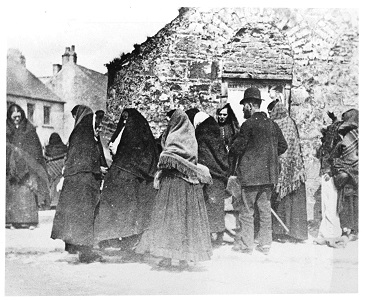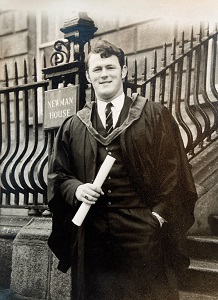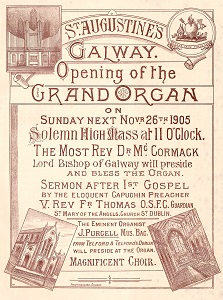Old Galway
PEADAR O’DOWD, THE PASSING OF AN OLD GALWEGIAN

by Tom Kenny
Peadar O’Dowd’s credentials for writing about Galway were impeccable. One of four children, Nono, Willie, Martin and Peadar born to their parents John and Bridget, he grew up in Bohermore and was always grateful for the fact. He lived his life there and throughout that life would celebrate the area and its people in hundreds of articles and interviews he published in various newspapers and journals.
He was educated in St. Brendan’s in Woodquay and in St. Mary’s College where he spent ‘five of the happiest years of his life’ and later completed a Commerce degree in UCG. Having graduated, he taught for a year in “The Mon”, then went to teach in St. Benin’s Vocational School, Glenamaddy where he also managed to coach the camogie team to win the County Schools championship in 1969. He eventually moved on from there to join the staff of The Regional Technical College as a lecturer in Business Studies. He was fortunate to meet and marry Mary Langan from Cross, Co. Mayo.
THE MERRYWEATHER

by Tom Kenny
Moses Merryweather and his son Richard lived in Clapham, London and they worked with the engineer Edward Field on putting his design of a vertical boiler onto a horse-drawn platform. They successfully applied it for use in their steam fire engine thus improving water pressure and making it easier to use, once steam had been got up. It was reckoned that the engine could get up enough pressure to pump within ten minutes of a call out. The fire could be started before leaving the station so there could be enough pressure by the time they arrived at the scene of the fire. In 1899, Merryweather produced the first successful self-propelled steam fire engine. Appliances were available in small sizes suitable for a country house pumping around 100 gallons per minute. A common size, popular with Borough Fire Brigades was the double vertical boiler that could pump between 250 and 400 gallons per minute.
THE LITTLE SHOPS OF BOHERMORE

by Tom Kenny
There were a few little shops at the top of Prospect Hill leading up to Bohermore -- Kelly’s shop was where you got the thickest penny ice cream between two wafers. There was McInerey’s, Mary kate Mahon’s and Lohan’s chemist. Almost next door was Tom Duffy, the tailor. On the other corner of Biddy’s Lane was Molloy’s little shop – neat as a pin.
Across the road from Water Lane was a small shop which later became Sharkey’s. I vaguely remember a fish and chip shop and even a small laundrette along that row. Mr. Cloonan, the carpenter, had a coffin shop along there also. He was a very friendly man. If his door was open when we were passing, being children, we were afraid to look in in case there might be a fully occupied coffin looking out at us.
Crowe’s Bar, Paddy Hogan’s Pub were close to each other and Luke Doherty’s Pub was directly across the street. The three proprietors would stand at their doors after last mass on Sundays, hoping to attract customers to their house. They were known locally as ‘the Father, the Son and the Holy Ghost’ – I never knew which of them was which.
THE HOMES OF WOODQUAY

by Tom Kenny
As we pointed out last week, much of what we now know as Woodquay was under water until the funnelling of the various streams that came down from the Corrib into the river that we know today began in the mid-nineteenth century. As part of the project, the lands of Woodquay were gradually reclaimed. The people living in the area in those early years were mostly small farmers and fishermen. Their houses were very basic, single story, and for the most part, thatched and built of crude stone. There were of course some landmark houses but things began to change generally around the turn of that century with the construction of terraces of new slated houses around the broad space of Woodquay as we know it today, mostly built by the Urban District Council.
MARKET DAY IN WOODQUAY

by Tom Kenny
MARKET DAY IN WOODQUAY
There were a number of aspects to the market in Woodquay in the nineteenth and early twentieth century – there was a crane for weighing potatoes at the end of the park (near the toll booth) and it was there many of the farmers who carried their wares downriver used to gather to sell. Other groups would congregate here to sell scallops for thatching houses, ‘flexible sticks’ cut from hazel trees. These were very much in demand in the city area as so many houses were thatched in those days including in Woodquay. Also in that area you would find basket makers who would weave creels, ciseáins, skibs and baskets of many shapes and sizes for sale to the public.
AN AMERICAN BARBER SHOP IN EYRE SQUARE

by Tom Kenny
John Joseph Grant emigrated to Brooklyn in New York where he learnt the haircutting trade and obviously made enough money which enabled him to come home in 1912 and set up his own business here. He also picked up quite a few tips on advertising as well as you can see from our illustration which was published c.1913. In addition to being a skilled barber, he certainly was not shy about promoting his wares – his advert is full of superlatives. “I guarantee to cure dandruff – the most modern and up-to-date barber’s shop in the Provinces –shaving soap solely manufactured by J.J. Grant – you will never get bald if you use Grant’s Imperial Hair Tonic (He must have sold this product out as he himself went bald in later life).
LARRY CHEEVERS

by Tom Kenny
Larry was the eldest child of Jack and Ethel Cheevers who lived on Dalysfort Road in Salthill. They were the owners of the Forster Park Hotel and the iconic Park Café which was attached to it. Larry was educated in the Jes and in Castleknock College and went on to study dentistry in UCG, you could only do first year there at the time, and later in UCD where he finished the course and qualified.
He was a naturally gifted athlete and was involved in many sports starting in Secondary School. He was a good swimmer and swam competitively. In 1958, he became the Irish Junior Champion in the 7 lbs. shot and in doing so, broke the Leinster and Irish records. In 1960, he was the All-Ireland 220 yards intermediate sprint champion and represented his country in both the discus and shot putt in the Catholic Student Games in Spain.
HEAVENLY MUSIC IN GALWAY

by Tom Kenny
On the 26th of November 1905, the new organ in the Augustinian Church was launched at a high mass. The organ was placed ‘in the western gallery of the church in a handsome varnished case of specially selected woods, stands 26 feet high and 25 feet wide. The front pipes, some of which are over 18” long, are gilt and present a superb effect. The sides of the organ are recessed to leave room for an augmented choir and for the present, the organ is blown by hand at one end of case; at a future time it is hoped to apply a hydraulic motor to do this work. There is great variety in the tones of the various stops and the general effect of all combined is truly magnificent. The entire work reflects great credit on the builders who built it at their factory in Dublin. The number of speaking pipes in the organ is close to 2,000.
Our illustration is of the cover of the programme of music that was played on that day. As time went on, the presence of the choir became unreliable and sporadic, people drifted in and out with no real commitment. In the late forties, the Prior, Fr. Thomas White set about re-organizing it and appointed Fr. Anthony Mansfield as choirmaster. It was he who really set up the choir properly. His ambition was to have the best choir in Galway ready for the upcoming centenary in 1955 of the Augustinian Church.
